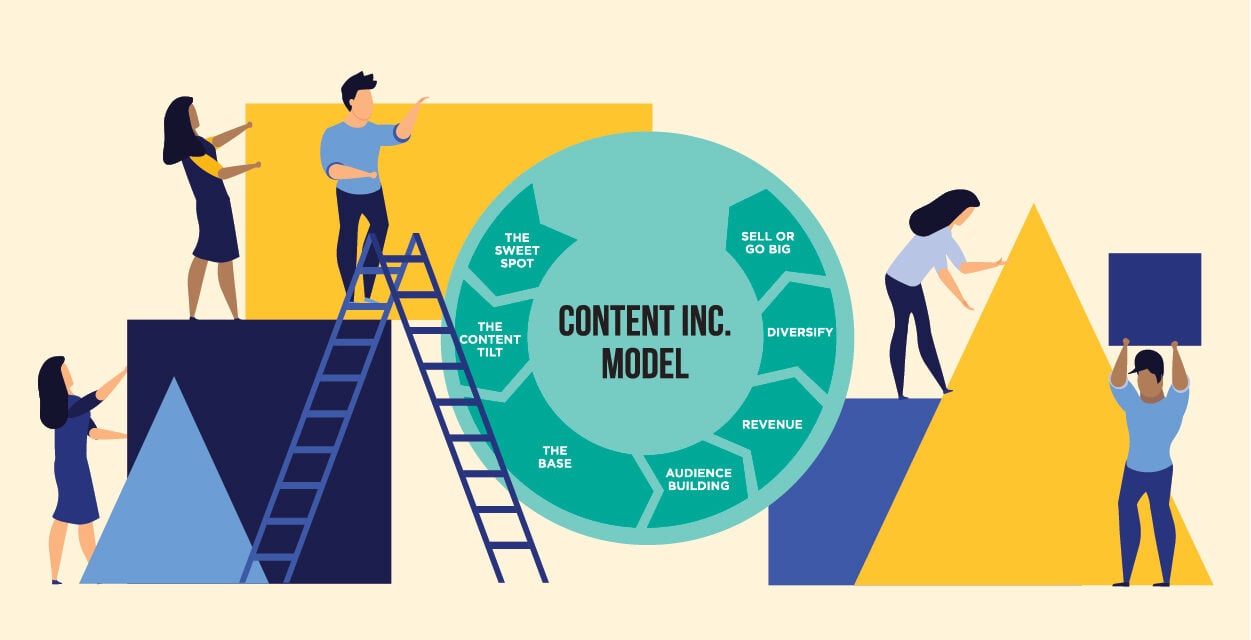Table of Contents
Starting a content business: where content marketing meets entrepreneurialism
How to use content marketing tools and concepts to build a business out of content alone.
A sound growth strategy built on marketing and digital content has many moving parts. From social media to search engines, it can be hard to know where to focus your attention. And while every element of your strategy is important, some are more crucial than others.
But in most cases, content creation is the greatest challenge, one that impacts every aspect of the project.
After all, content doesn’t just help to build trust and relationships with your audience; it can also drive other areas of your business.
It’s the springboard for attracting informed customers, improving conversion rates, building relationships and creating a sense of community around a brand.
It’s time you started thinking about your approach to business through content. We’re not talking about content marketing, which we’ve already covered and will continue to cover on this blog. No, we’re talking about a content business: In other words, the first steps towards building a business based on content.
But first, let’s take a step back…
Before we go on, we need to briefly return to content marketing.
Content marketing involves planning, creating and sharing content with your audience.
It’s about tailoring webpages, videos, eBooks, social media posts and more to your target and switching to an inbound approach (people come to the brand) from an outbound one (the brand pushes its message out to people). When this content lines up with consumers’ needs, desires and preferences, you’ve got a winning strategy.
Where do you start? Simply posting something online and hoping it goes viral isn’t enough: before speaking to your customers, you have to know who you are, what you want to say and who you want to speak to:
- What are your goals? As with any marketing activity, you need to know where you’re going so you can work out how to get there. Setting short- and long-term goals will help you focus your content strategy. The first step is to map your customers’ journey to understand how to meet their needs at each step along the way.
- Do you have a solid brand? For content to be effective, it has to come from a well-positioned and recognisable brand. Knowing how your company is perceived by customers will help you understand what tone of voice and methods to use so that you remain consistent with your image. If you haven’t already done so, now’s the time to define your brand identity.
- Do you know your customers? Content marketing should be oriented towards the customer and their interests, behaviours, habits, motivations, influences, lifestyles, desires, needs and preferences. It’s important to develop a full profile of your customer, including their journey towards your brand, so that you can create stories that inspire and motivate them to buy what you’re offering.

How to develop a content-driven business
Now that we’ve briefly recapped the key tenets of content marketing, let’s turn our attention to the concept of a content business, which takes some of the same tools and ideas and uses them more strategically.
Today, many brands are being built on content. Some even start out as content alone, only to evolve into something more later.
You’ll find a deep dive into the content business model here, while in the rest of this article we’ll take you through the key stages of developing a content-driven business – from analysis to strategy – backed up with examples.
1.Analysing the audience
Far be it from us to dumb down complex processes… But have you ever wondered how Chiara Ferragni became Chiara Ferragni? (We’ve taken this celebrity as an example precisely because she used a content- and data-driven approach to make herself one of the world’s most successful influencers.)
At the risk of oversimplifying, the answer is: by continuously analysing and testing her audience.
That’s really how she did it: first as a communicator, then as a blogger, and finally as an influencer and celebrity, Chiara Ferragni has produced a myriad of multimedia content over the years, positioning herself on the main digital and social media platforms before everyone else and testing the effectiveness of her content on her audience.
Chiara Ferragni a growth hacker… who’d have thought, right? 😉 But she really is. And here’s why you probably don’t like her fashion collection: it’s not aimed at you! On the contrary, the items in her collection are the result the many data points and insights gleaned from constantly analysing the performance of content posted and conversations started in search of patterns.
A word of caution: to run a successful content business, it’s vital to first build a user base. Only then can you sell them something, under certain conditions. It’s the other way round from a traditional business model, which is based on opening a store from scratch and then attracting people you don’t know to it.
Analysing your audience from an anthropological and ethnographic perspective is a fundamental step to developing a content business. Because while it’s true that today’s firms act as if they are media companies, producing a constant stream of content, its effectiveness has to be continuously tested and measured to guide future content marketing actions. This is the only way to be sure that they generate the desired actions and reactions from the audience.
At the same time, it’s important to know what people are talking about, what type of content they usually consume, how they do it and which celebrities and influencers they follow. Information from website analytics and CRM systems gives you key insights into customers’ habits, while external research can provide you with an overview of the target audience. Some tools that can help in this phase are:
- BuzzSumo or Ubersuggest to see which content on a given topic is already attracting people online.
- Quora or Reddit to analyse what sorts of questions people are asking online and how they’re interacting on a certain issues.
- Semrush or Ahrefs to identify the most popular keywords for a topic and see which perform better than others.
Once you’ve identified your macro topics, you need to break each one down into sub-categories so you can weave content into the customer journey.
2.Identifying minimum viable content
As we touched on above, properly analysing your audience allows you to identify “pillar” content and themes around which you can build your business. To do so, you first need to identify what’s known as minimum viable content (MVC): this is the smallest amount of content that, when shared with the audience, tells you something about them or influences their actions. As you gradually learn more about what your audience wants, you can create ever more ambitious and specific content.
For example, the route that Joe Pulizzi has taken with the Content Marketing Institute is illuminating. Having started life as a content marketing magazine, a decade or so later (in 2016), the CMI was sold to UBM. In the meantime, it had grown into:
- A marketing magazine offering free and paid content curated by an international team of editors
- A content marketing consultancy
- The organiser of the most important content marketing event on the planet (Content Marketing World)
- A publisher of books on digital marketing
All this was achieved by continuously analysing its audience and tailoring its offering accordingly. We highly recommend reading their article on minimum viable content, How to Stop Wasting Time on the Wrong content.
A similar path was taken in Italy by Alessandro Rimassa – CEO of TAG Talent Garden – when he founded Radical HR. What started out as an editorial hub then grew into a community for sharing best practice between HR professionals. Today, it’s all this and more:
- An advisory firm
- An HR training centre
- An observatory on the future of work
Radical HR is driven by the insights that come from its customers and collaborators, who share their experiences and expectations.
The examples of the Content Marketing Institute and Radical HR also highlight another key aspect of a successful content business: the need to diversify revenue streams.
3.Content mapping to support your business
Your MVC is bearing fruit… Yay! Now you can switch to a minimum viable content strategy (MVCS).
The problem with a “traditional” content strategy often lies in the nature of strategy documents: they tend to be PDFs, Excel sheets and/or slide decks. In our day-to-day actions, we rarely check these documents to ensure that they’re aligned with our strategy.
Inspired by the agile model for product development, MVCS is about giving your audience what they want, when they want and how they want, learning from the ways that the audience engages with content.
With this bottom-up approach, driven by data and community AI, a more complex content strategy can be built. Content mapping is a strategic way of creating useful, relevant, informative and timely content for your target audience.
We’re now going to map a customer journey in four main steps using the see, think, do, care framework devised by Avinash Kaushik:
- See: This is the phase when the customer approaches the brand for the first time; it’s about inspiring people. To do so, you need to create content that has nothing to do with sales. We’re working with dreams and people who dream don’t wanted to be rudely awakened with a sudden “Buy now!”. At this stage, customers will have lots of questions, so the most suitable content might be guides, infographics, videos or posts on social media channels.
- Think: The next step is to inform people. Purchasing intentions are still weak and need reinforcing, so it’s crucial to create useful and informative content because it’s at this “consideration stage” that you can stand from competitors. Effective content in this phase might be explainer videos, articles on experiences using a product, or a newsletter covering topics of interest to customers.
- Do: Here the goal is to convert people into customers. Your audience is now informed, inspired and has shown an inclination towards making a purchase. They don’t need to be pushed into purchasing, but they need to satisfy their needs without encountering any difficulties. Content like reviews, testimonials, case studies, eBooks, landing pages with dedicated coupons or FAQ are all useful for guiding the customer through this phase.
- Care: This is the most important phase for creating loyal customers. Looking after people who have already made one or more purchases is essential for broadening your customer base and incentivising them to return in the medium-to-long term. Here, it’s vital to create personalised content like emails that are targeted based on user preferences or user guides for products purchased.
It can be helpful to create a short document for each macro-category above so that you can then organise content throughout the customer journey. A practical example is provided by Andreea Macoveiciuc and her template for publishing a video course.
Espressoh, the beauty brand launched by Chiara Cascella, has risen to prominence thanks to its transparent, minimal and cross-cutting marketing based on constantly listening to its audience. It’s transparent in its direct and sincere voice, even tackling taboo subjects in its Oh.BAR beauty and lifestyle blog. It’s minimal in its style, which is elegant but sustainable. And it’s cross-cutting because it always manages to blur the boundaries between spaces: for example, it has launched initiatives combining art and cuisine by offering compelling content in an innovative guise. It’s Oh.BAR popup stores are legendary, allowing people to enjoy a good cup of coffee while testing products. As Chiara Cascella explains:
Being able to communicate our brand identity in such a coordinated way is fundamental for us. It doesn’t matter if we’re talking about make-up or a dress. Visual and communication trends need to be followed, studied and tailored to your own brand identity.
Takeaways
In this article, we wanted to outline the first steps you need to take in setting up your own content business: a business built on content that gradually becomes smarter and more informative for entrepreneurs, and which sees content as fundamental for business growth.
The cases of Chiara Ferragni, the Content Marketing Institute, Radical HR and Espressoh show us that interesting new avenues lie ahead for those able to master digital environments and produce relevant content.
Before we go, here’s one last tip for you: sign up to a great newsletter called The Tilt. Founded by Joe Pulizzi from the Content Marketing Institute, it’s aimed at content entrepreneurs and creators, and has stacks of stories and advice about running a content business.

